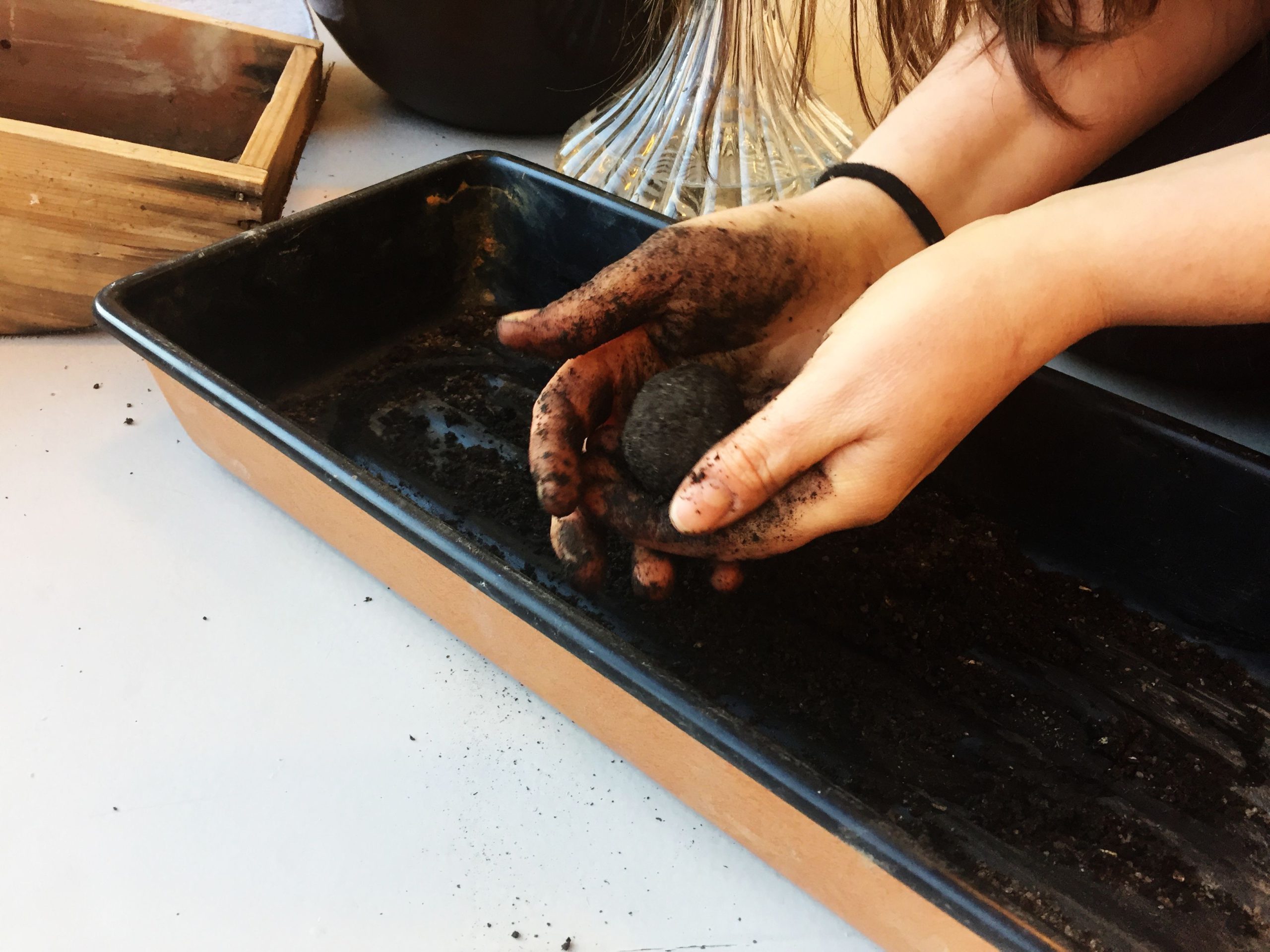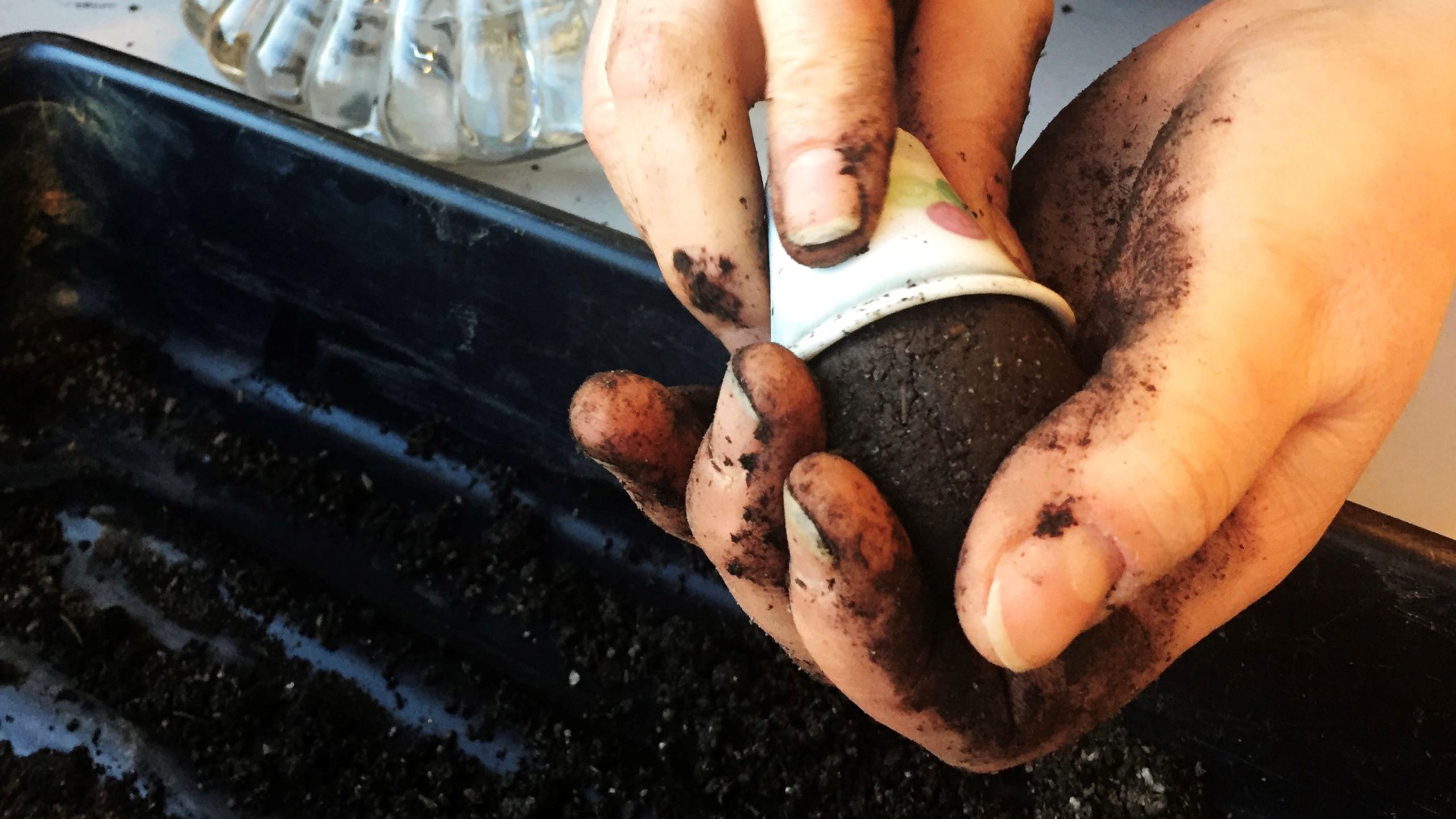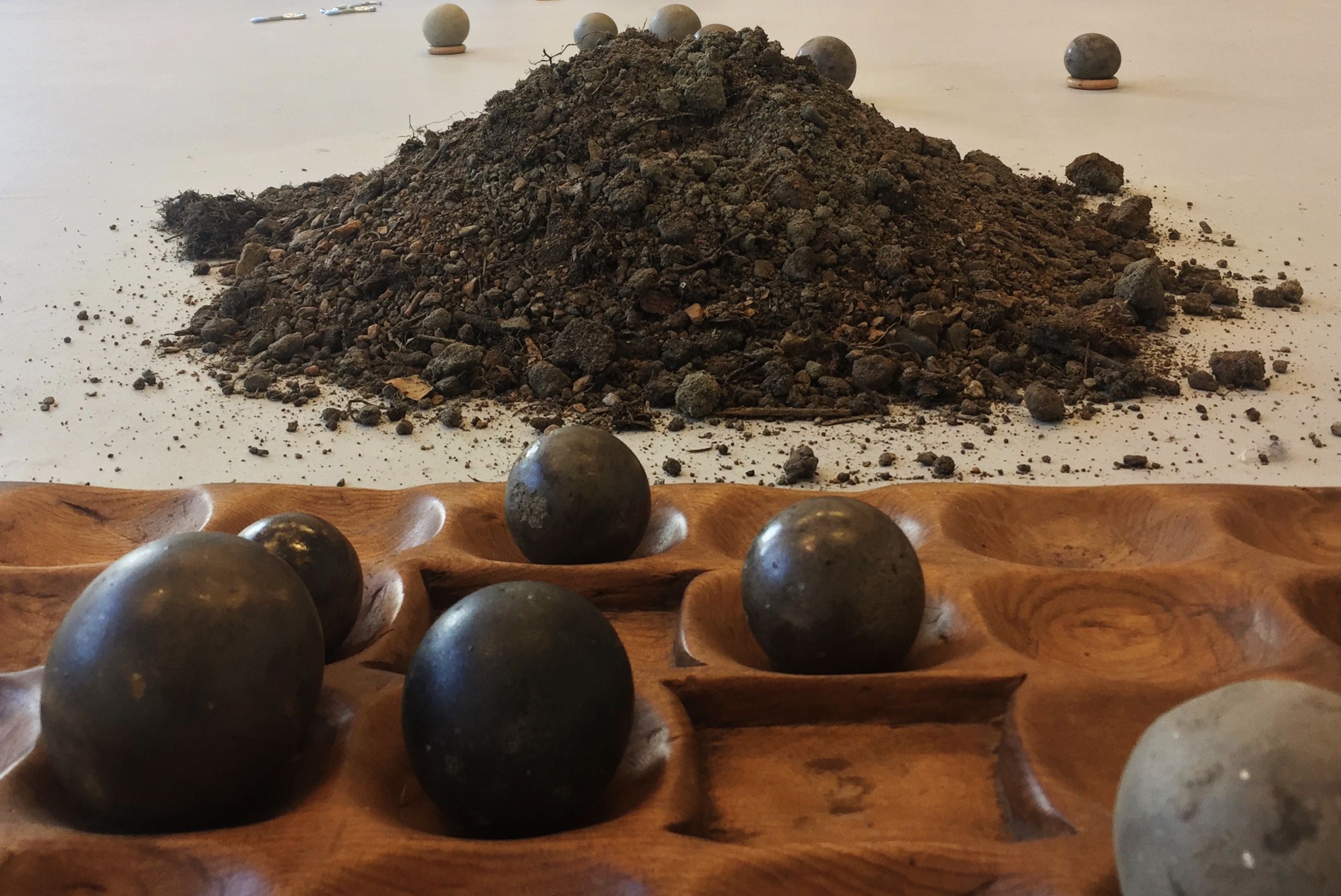A snapshot from a cold winter day in February 2021:
A faint odour of minerals, rich in iron, perhaps copper, hangs over the art gallery Babel Visningsrom in Trondheim. As artist Veslemøy Lilleengen starts working a fresh bucket of soil with her hands, adding water and kneading the earth between the palms of her hands, this intensifies into the rich scent so familiar to many of us from gardening, a mixture of freshness and decomposition, dry dirt and teeming life. This particular bucket has been left to dry a bit longer than is good for the earth and those living organisms, made evident by an earthworm that at first seems dead, but starts moving feebly after being hit by a splash from the water jug.
For several months Lilleengen has been hosting workshops with participants from various areas of the city of Trondheim. The simple activity of kneading soil, which has to be done for hours to render the smooth, marble-like spheres that are spread across the floor of one third of the gallery, brings people together in a unique way. Repetitive, yet something to do with your hands, something to rest your gaze on, it opens up for a relaxed form of conversation quite rare among strangers. These conversations, the interactions and encounters that take place between the workshop participants, are as much “part of the art” as the hands-on encounter between participants and soil. But they also belong only to the few who actually take part: once a workshop is done, the only remnants of the shared thoughts and stories are the soil spheres. About the size of golf balls, but much denser, they vary in colour and sheen, natural enough since they were made from soil brought by the workshop participants from their home areas. Some have clear trails of red running through them, others are a smooth, almost golden brown.
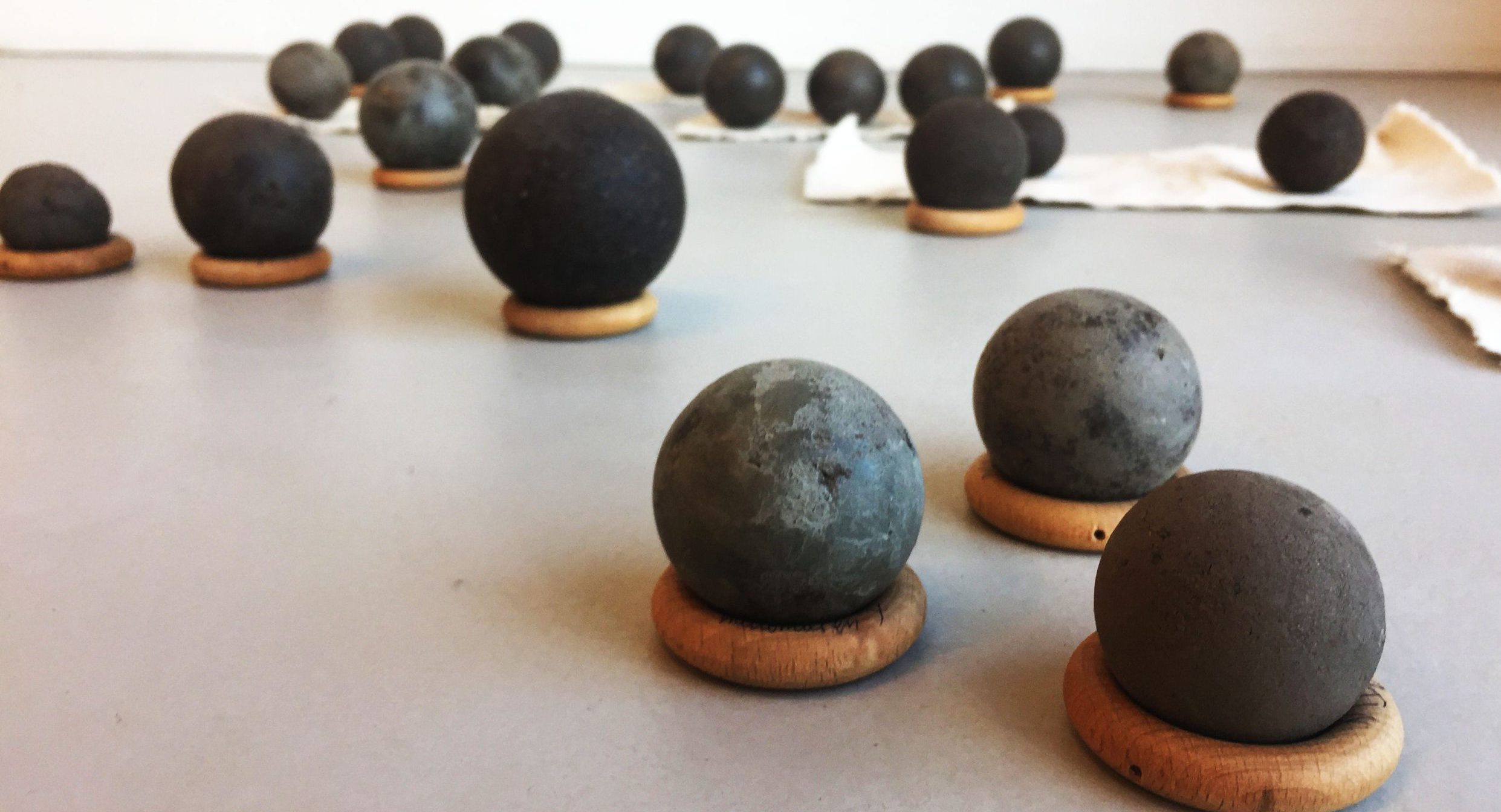
The simple activity of kneading soil, which has to be done for hours to render the smooth, marble-like spheres that are spread across the floor of one third of the gallery, brings people together in a unique way. Repetitive, yet something to do with your hands, something to rest your gaze on, it opens up for a relaxed form of conversation quite rare among strangers. These conversations, the interactions and encounters that take place between the workshop participants, are as much “part of the art” as the hands-on encounter between participants and soil.
Working with soil
The fact that the conversations are not in any way recorded is important to the informal sharing atmosphere, Lilleengen feels. During workshops, far from aiming to “moderate” the conversations, she tended to move between groups, checking that they were working their lumps of earth with the correct amount of wetness, sharing snippets of her own background, stories that popped up in her head, and the participants did the same. People have a greater need to talk than usual, she has seen, in these times of Covid. The framing of bringing soil from your own surroundings means sense of place and belonging were central topics, some talked about gardening or burial rites, but casual conversation ranging from food to the strains of the Covid situation were the norm.
For Veslemøy Lilleengen, working with soil and other organic materials is something that comes naturally. She was raised on a farm, in the area of Ørlandet in Trøndelag, mid-Norway. Her mother is also a visual artist, her father runs the farm, and has his own R&D company developing bio-gas and odourless fertilizer. Grunntanker is a continuation of the project Jordtanker (2019-20) in which she developed the technique of making the spheres, and exhibited them alongside an eponymous poem that ranges over family, farm, childhood memories, and the retrospective shame of having buried a dog in plastic. The up-close and personal style, drawing on personal experience and sense of belonging, characterize all of her work, along with a strong political sensibility. In Grunntanker, there has been some attention paid to areas of Trondheim where the soil is polluted or depleted, such as old factory grounds. She plans to lift up this element further in a next iteration of the soil sphere project by working with soil that contains extreme amounts of plastic.
Potty blue
Since graduating from the Trondheim Academy of Fine Art in 2018, Lilleengen has quickly made a name for herself. Identity and place explored through base materials are recurring topics: Her Master’s project used the age-old technique of colouring textiles with indigo dissolved in fermented urine – in Norway poularised by Hannah Ryggen (1894-1970) as “Potteblått” (potty blue), which is also the title of Lilleengen’s artwork – to create unique “portraits” of individuals through their urine, elevating the low-status dye through applying it to silk fabric. In the process, she overturned the widely held belief that men’s urine was better than that of women. She gets properly animated when describing how people thought you could not use women’s urine at all as long as they were of menstruating age, and that urine from women of any age would yield a lighter, weaker blue than that of men. From the back room she draws forth the lengths of silks, marked surreptitiously with the name of each urine donor. While all a clear blue, the hue varies quite a bit, and some are lighter in colour than others, but the names on each silk cloth confirm that the difference in hue does not follow a gender pattern.
Ryggen is a clear source of inspiration for Lilleengen, who is now part of the artist collective Hannah Ryggen Army. Although born in the Swedish city of Malmø, Ryggen married painter Hans Ryggen and moved with him to Ørland in the mid-1920s. The shared home region is only one of several points of connection Lilleengen feels to this great artist. She grew up hearing stories about the textile artist, who liked to surround herself with an air of mystique and became infamous among locals for asking for their pee. But Lilleengen sees her practice as far from mysterious, rather very down-to-earth. According to Ryggen’s nephew, she also contributed generous amounts of urine herself to her Potteblå colour. Lilleengen stresses that this was not long ago – Hannah Ryggen died in 1970 – but that people today have a more distanced relationship to their bodily fluids, considering it somehow “unnatural” to make use of these for craft purposes, whereas throughout history that has been as natural as can be. Carrying on the craftsmanship of creating the colour is important to her.
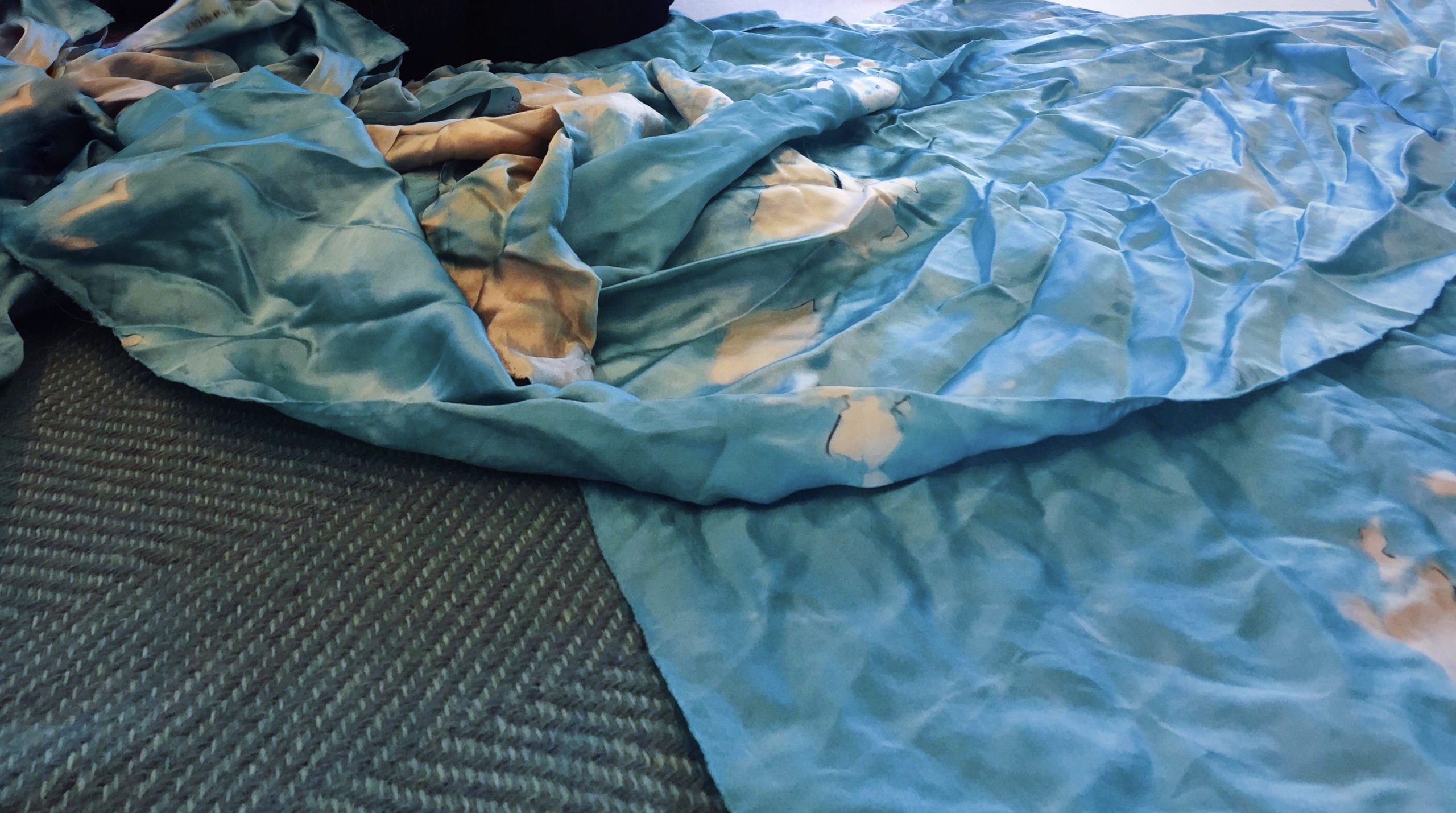
Norsk Bauta (Norwegian Bauta) – collecting urine from women artists all over Norway
This year, Lilleengen’s name hit the mainstream media hard when she launched the ambitious project Norsk Bauta (Norwegian Bauta), which seeks to collect urine from women artists all over Norway over a period of 11 years. She has already started with her home county of Trøndelag and plans to cover one county per year. “It is not like I will be working on this full-time for 11 years”, she observes with a laugh, “I just send out a keg to the artist, ask her to fill it up over the course of a week or so, and then come around to collect it” (it is harder to send a keg-full of urine via regular mail than you might think). The collected urine needs to ferment for a minimum of two months before it can be used to dye textiles, but in most cases it will probably be left for much longer. The artist plans several outcomes for this project. One rather mundane one, overturning the idea of her Master’s project of elevating Potteblått, is a range of blue t-shirts, with the name of the artist who contributed the urine for the colouring process. This will be a cheap way of advertising for Norwegian female artists, who Lilleengen feels as a group receive far too little recognition.
She has seen far too many examples of excellent artists who are left out of art history, she observes, and states her aversion for the idea that one should not speak of “female artists”. “That’s the same as the worst kind of racism, claiming we should say ‘All Life Matters’ rather than ‘Black Lives Matter’!” she exclaims. “No! We have to point attention to the groups who are left at a disadvantage, not jumble them together with larger groups, so that everything seems fine. If we don’t look at ‘female artists’, only at ‘artists’, then there is no point in observing differences in pay, recognition and representation…” The community aspect of Norsk Bauta will be emphasised, in a textile sculpture that will emerge over those years, and she will be working with the needlework technology of tuft.
Working with plastic-ridden soil
As mentioned, Norsk Bauta is only one of several ongoing projects Lilleengen has planned. She will also continue her soil work. As we move from the soil sphere she has demonstrated, she pulls out another bucket of soil, this one generously run through with pieces of plastic, large and small. In the next iteration of the project, she wants to work with plastic-ridden soil, collaborating with a team of scientists. She is concerned with the pollution that is in the soil around us, visible and invisible. While large pieces of plastic are super-visible, there is so much microplastic and other pollutants whether pesticides and other chemicals or heavy metals, that we cannot detect with the human eye. Lilleengen says we can easily feel that we are living in dystopic times, and she does not want to contribute to an aesthetisation of dystopia – but using this literally down-to-earth approach, lifting forth old craft traditions, creating understanding for traditions and the sense of connection to our environment and what has come before, she sees a fruitful way of commenting on our current times. “When it comes right down to it, it is all about inheritance and attachment”, she says. “The connection to your family, your surroundings, the life that has come before”.
About
Veslemøy Lilleengen is a Norwegian artist from Trondheim. Find out more on the personal website.
